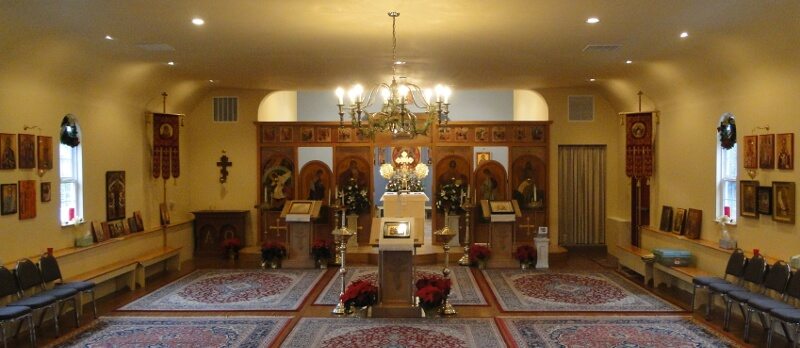If your parish is on the Old Calendar, today is Christmas Eve. If your parish is on the New Calendar, today is Theophany. If you’re in a bicalendar parish, today is at once Christmas Eve and Theophany, a day of fasting and a day of feasting, the final day of preparation for the appearance of Christ as a baby, and the day on which we celebrate the initiation of his adult ministry.
How did our parish come to be a bicalendar parish? That’s an easy story to tell. Our parish was founded in 1900, but after 1929, it didn’t have a priest. For over fifty years, it was served by priests from Seattle. These priests came and celebrated the liturgy on certain Saturdays each month to minister to the needs of the community. At the beginning of this time, the parish was on the Old Calendar, and the liturgies were served in Slavonic.
Over time, the priests serving the parish began to use more and more English in the services. By 1985, the parish was on the New Calendar, and the services were entirely in English.
But there are still many first-generation Slavic immigrants in the area. Ten years ago, our parish began having a priest come down from Seattle to serve the needs of this part of our community. These priests come and celebrate the liturgy on one Saturday each month. These liturgies are on the Old Calendar, and they are served in Slavonic.
That’s why we’re celebrating both Nativity and Theophany this week, our Lord’s birth and his baptism.
But don’t think that means that our Old Calendar brothers and sisters are celebrating Christmas on January 7. We all celebrate Christmas on December 25. It’s just that, if you’re on the Old Calendar, when the liturgical calendar says December 25, the civil calendar says January 7.
And then, of course, there are the Armenians, who still combine the celebration of the Nativity and Theophany in a single feast on January 6. That was the original practice of the Church: on a single day, we celebrated all of the events related to God’s appearance: the birth of Christ, the visit of the Magi, the circumcision of Christ, his presentation in the temple, his baptism, and the manifestation of the Holy Trinity.
Over time, the commemorations were gradually split off onto their own days. First, the Nativity was moved to December 25, so that it fell exactly nine months after the Annunciation. Then the Circumcision was moved to January 1 and the Presentation to February 2, eight and 40 days after the Nativity.
In the Western church, Theophany came to be known as Epiphany and to focus on the visit of the Magi and the revelation of God to the Gentiles. In the Eastern church, the visit of the Magi moved to December 25, with the Nativity. Theophany became the feast celebrating the baptism of Christ and the manifestation of the Trinity.
Whether you’re celebrating Christmas Eve or Theophany today (or both at once), may God grant you much joy.
The Troparion for the Forefeast of the Nativity
Mary was of David’s seed,
So she went with Joseph to register in Bethlehem.
She bore in her womb the Fruit not sown by man.
The time for the birth was at hand.
Since there was no room at the inn,
The cave became a beautiful palace for the Queen.
Christ is born, raising up the image that fell of old.
The Troparion for Theophany
When You, O Lord, were baptized in the Jordan
The worship of the Trinity was made manifest,
For the voice of the Father bore witness to You
And called You His beloved Son.
And the Spirit, in the form of a dove,
Confirmed the truthfulness of His word.
O Christ, our God, You have revealed Yourself
And have enlightened the world: Glory to You!
Read More
Thoughts on our house blessing: We always try to make sure our home is spotless before we get it blessed. But the messy parts of the house need blessing, too.
Groundhog’s Day and the Presentation of Our Lord: February 2 is a busy day. It’s my birthday. It’s also Groundhog’s Day, and it’s the Feast of the Presentation of our Lord in the Temple, sometimes known as Candlemas. So what do these days have to do with each other?
Justinian and Theodora: A Love Story: St. Theodora, the wife and co-ruler with St. Justinian the Great, is one of my very favorite saints.
Buy the Book: The Saint Nicholas Day Snow
Shoes or stockings? Horse or sleigh? Does St. Nicholas visit on December 6 or on Christmas Eve? Will a little girl’s prayer be answered? When Elizabeth has to stay at Catherine’s house, she’s worried about her grandmother, and worried that St. Nicholas won’t find her. The grownups, though, are worried about snow.
Celebrate the wonder of St. Nicholas Day through the magic of a book: The Saint Nicholas Day Snow. Available on Amazon, Bookshop.org, or my webstore.




